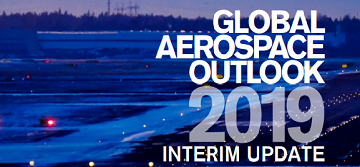
Written by Oli Newton, Aerospace Policy Adviser
The global aerospace industry in 2019 faced several headwinds but deliveries reached an annual value of up to £29.5 billion to UK industry, driven by record highs in widebody deliveries. Overall deliveries were down on the record heights achieved in recent years, but we are confident demand remains strong and production rates will again begin to rise in the months and years ahead.
At the end of 2019 ADS and the Department for International Trade published an interim outlook for Global Aerospace, which ADS members can read here. This outlook identifies some key trends and opportunities out to 2038.
Current industry trends
The International Air Transport Association (IATA) predicts passenger growth of 5% in 2019, which is slightly slower than previous years. Major reductions in growth have been experienced by Asia-Pacific, Chinese, Indian and Middle-East airlines. We can however expect some of these markets, alongside Africa and Latin America, to continue to be the key areas of passenger growth out to 2038.
2018 was a record year for Airbus and Boeing deliveries. As mentioned earlier, Airbus have enjoyed another strong year. 863 deliveries is a new record for Airbus. This, coupled with a high number of orders (768) and a significant backlog (7,482), means they are in a good position long term.
Boeing on the other hand had a very difficult year as a result of the grounding, and subsequent halt in production, of the 737 MAX. Their priority for 2020 will be to prove the airworthiness of this model and get back to delivering the orders they have on backlog.
With the increased attention on environment and sustainability, many people will be looking for the next generation of aircraft, and the improved efficiency that comes with them. We can expect the current trend of incremental development of existing aircraft platforms to meet the bulk of near to mid-term demand. Examples of this include the Airbus A321neo XLR and Boeing’s 777X, which they hope will enter into service this year.
Looking further ahead
While the sector continues to develop the green technology that will power flight in the decades to come, there will be a focus on the areas of growth globally. The value of aircraft deliveries in the Asia-Pacific region going to be significant for the industry in the years ahead. This is where the bulk of narrow and widebody aircraft will be delivered, which aligns with the expected passenger growth globally.
Manufacturers around the world continue to work on the opportunities for the coming years. As the report highlights, there are several projects underway across the various stages of programme lifetimes. The outlook is positive, and ADS will continue to work with its members and Government to ensure the UK aerospace sector is well positioned to take advantage of the opportunities ahead.





